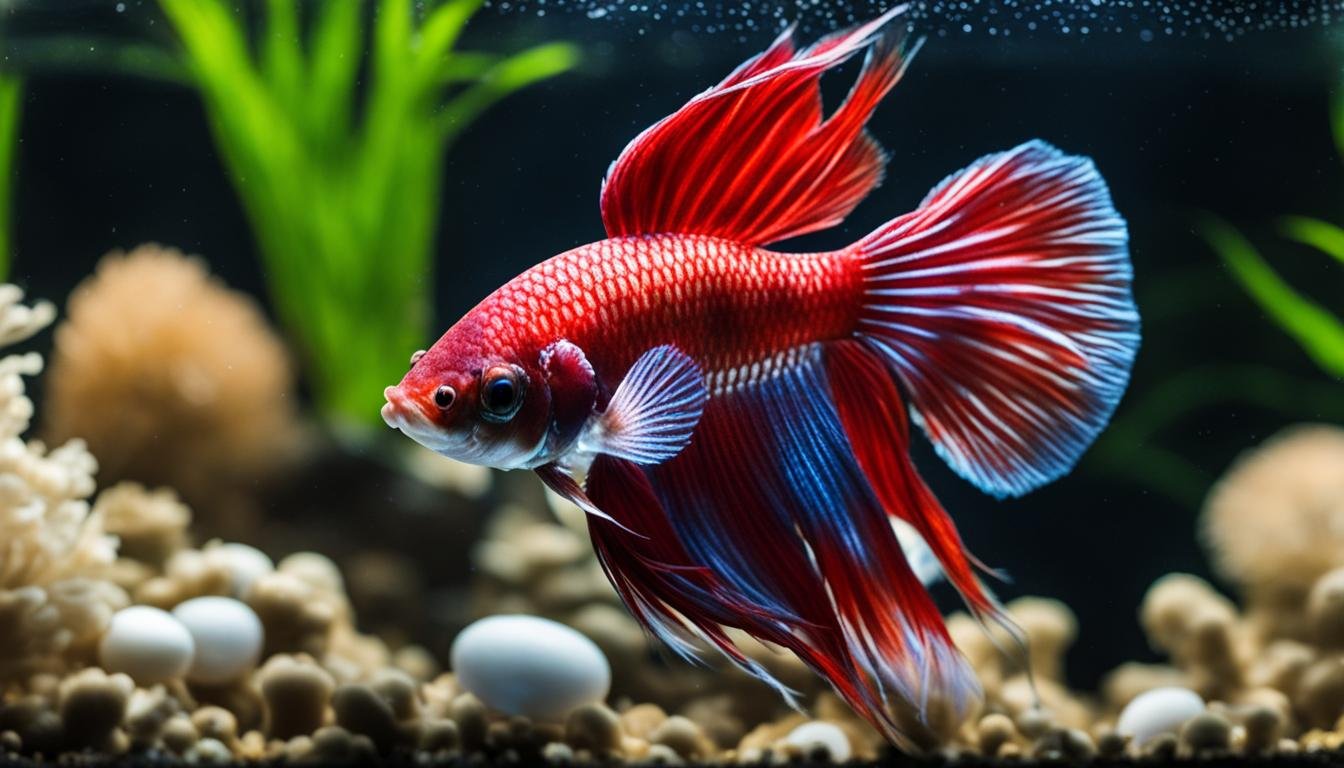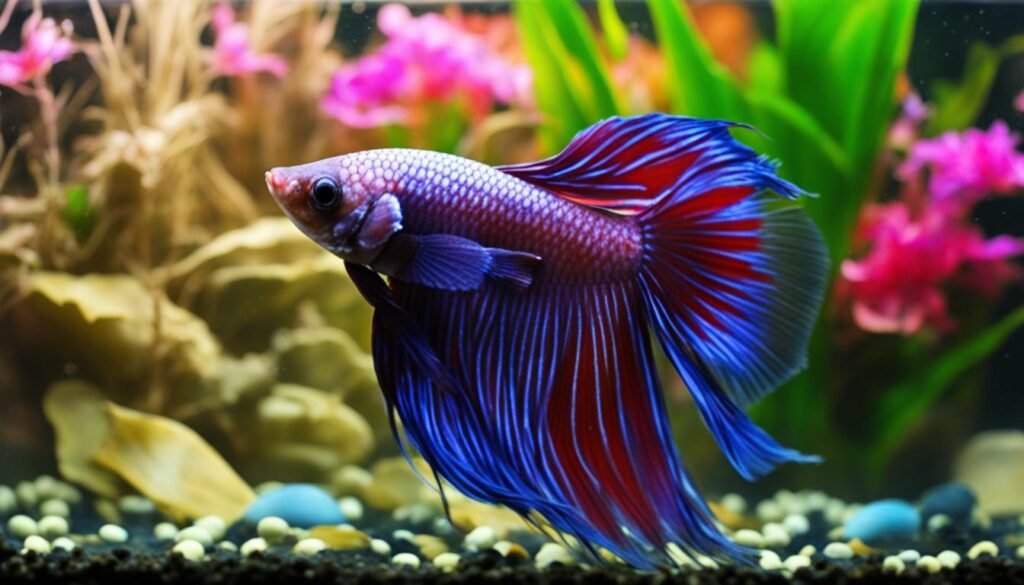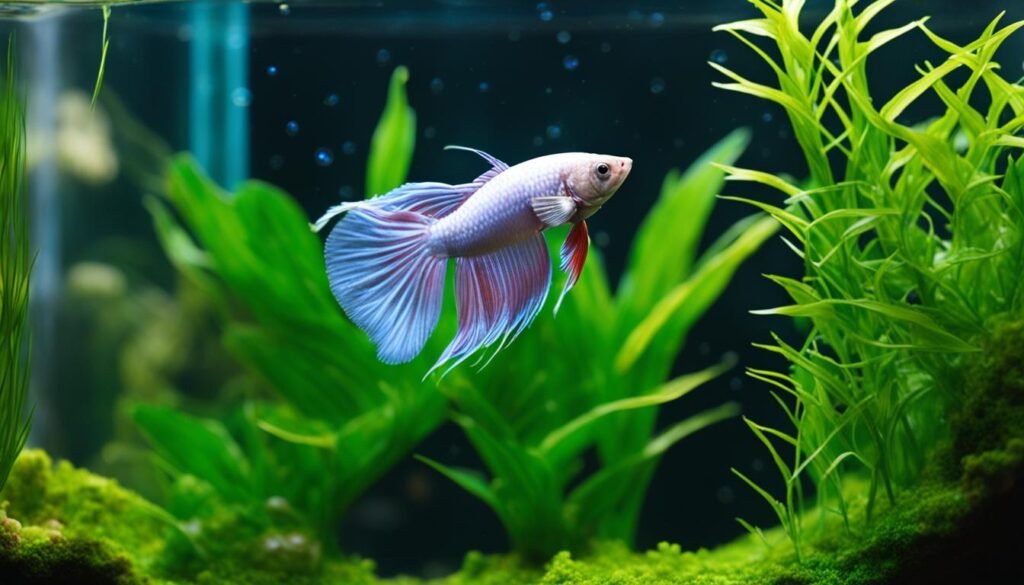Your cart is currently empty!

Can Female Betta Fish Lay Eggs Without A Male? Find Out!
Female betta fish are known for their fascinating reproductive behavior. One of the most intriguing aspects is their ability to lay eggs without the presence of a male. This unique behavior raises questions about the breeding habits of female bettas and the possibility of reproduction without mating.
Understanding the egg laying behavior of female betta fish is essential for betta fish owners. In this article, we will explore the reasons behind a female betta fish’s ability to lay eggs without mating, what happens after she lays the eggs, and how to identify if your female betta fish is ready to lay eggs. So, let’s dive into the fascinating world of betta fish reproduction!
Key Takeaways:
- Female betta fish can lay eggs without the presence of a male, but these eggs will not hatch without fertilization.
- Mating is the courting ritual where the male stimulates the female to release eggs, while spawning is the actual fertilization process.
- After laying eggs without a male, the female may reabsorb the eggs, cannibalize them, or choose not to care for them.
- Signs of a gravid female betta fish include the development of new stripes, a swollen belly, and attempts to make bubble nests.
- Understanding betta fish reproduction is crucial for proper care and breeding of these fascinating creatures.
Why Do Some Female Betta Fish Lay Eggs Without Mating?
Female betta fish have the remarkable ability to lay eggs without the need for mating. This unique behavior is possible because female bettas are highly fertile and can produce eggs on their own. Unlike mammals, betta fish practice external fertilization, where the male fertilizes the eggs outside of the female’s body. Mating, on the other hand, is the courting ritual performed by the male to stimulate the female’s egg release. Understanding this distinction helps explain why female bettas can lay eggs without a mate.
Female bettas do not require the presence of a male to produce eggs because they possess the innate ability to do so. As long as the environmental conditions are optimal, such as temperature, water quality, and proper nutrition, female bettas can go through the reproductive process independently. The male’s role in the reproduction process is primarily to fertilize the eggs and care for the nest, while the female’s primary role is to release the eggs.
It is important to note that without male fertilization, the eggs laid by female bettas will not develop into fry. Instead, they may be reabsorbed by the female, cannibalized, or left unattended. Betta keepers should be aware of these possible outcomes and take appropriate measures, such as removing unfertilized eggs from the tank, to prevent water pollution and maintain the health of the female betta.
What Happens After a Female Betta Fish Lays Eggs Without a Male?
After a female betta fish lays eggs without a male, there are a few possible outcomes. It’s important to understand what happens next to ensure the well-being of your fish and maintain a clean aquarium. Here are the potential scenarios:
- Reabsorption: In many cases, the female betta fish will instinctively reabsorb the eggs if no mate is present. This is a natural process that allows the female to conserve energy and resources for future breeding opportunities.
- Cannibalism: Unfortunately, some female bettas may choose to eat the eggs they just laid. This behavior can be influenced by various factors such as stress, lack of suitable environment, or hormonal imbalances.
- Ignored Eggs: Some females may simply ignore the eggs and not provide any care or protection for them. In such cases, it’s crucial for the owner to remove the unfertilized eggs from the tank to prevent water pollution and potential harm to the female betta.
It’s important to note that without male fertilization, the eggs will not hatch into fry. Therefore, if you’re interested in breeding betta fish, it’s necessary to provide a suitable environment for mating and ensure the presence of a male betta for successful reproduction.
Frequently Asked Questions
- Can female betta fish lay eggs without mating? Yes, female bettas can lay eggs without mating due to their high fertility. However, without male fertilization, the eggs will not hatch into fry.
- What should I do with the unfertilized eggs? If the female betta fish chooses not to care for the eggs, it’s important to remove them from the tank to prevent water pollution. Use a small net or siphon to carefully remove the eggs.
- How often can female bettas lay eggs? Female bettas can release eggs every other week under optimal conditions.
How To Tell if Your Female Betta Fish Is Gravid
It is important for betta fish owners to be able to determine if their female betta fish is gravid or ready to lay eggs. By recognizing the signs of gravidity, you can better understand your fish’s reproductive behavior and take appropriate care measures. Here are some key indicators to look out for:
- New stripes on the sides of the female’s body: Gravid female bettas may develop vertical stripes along their body, indicating that they are preparing to release eggs.
- Presence of a white ovipositor: The ovipositor is a small, tube-like structure located near the ventral fin of the female betta. When it turns white, it suggests that the fish is close to laying eggs.
- Swollen belly: A pregnant female betta fish will exhibit a swollen and rounded belly due to the presence of eggs inside her.
- Attempted bubble nest creation: Female bettas may mimic the behavior of males by attempting to build bubble nests, indicating that they are in the breeding mindset and ready to lay eggs.
By paying attention to these physical changes and behaviors, you can determine if your female betta fish is gravid and take the necessary steps to provide a suitable environment for her reproductive process.
Betta Reproduction and Breeding Habits

Understanding the reproductive behavior and breeding habits of betta fish is essential for betta fish owners. Betta fish, also known as Siamese fighting fish, have unique mating rituals and behaviors that contribute to their successful reproduction. In this section, we will explore the fascinating world of betta fish reproduction and provide insights into breeding betta fish without a male.
The Courtship Ritual
Before mating, betta fish engage in a courtship ritual that involves both the male and female. The male betta builds a bubble nest at the water’s surface using saliva and plant matter. He then entices the female to accept the nest as a suitable place to lay her eggs. The female betta assesses the quality of the male’s nest and decides whether to proceed with spawning or reject his advances. This courtship process ensures the female’s eggs will be protected and cared for.
Female Betta’s Role
Female bettas have the unique ability to produce and carry eggs without the presence of a male. Under optimal conditions, female bettas can produce eggs every other week. However, without male fertilization, the eggs will not hatch into fry. The female’s primary role in the reproduction process is to release the eggs. Once the eggs are released, it is essential to remove them from the tank if they are not fertilized to prevent water pollution.
Alternative Breeding Methods
While natural mating is the most common method of breeding betta fish, there are alternative methods that allow fish breeders to reproduce bettas without relying on a male. These methods include bubble nest fertilization, where the eggs are transferred to the male’s tank after they are laid; cup spawning, which involves using a container to fertilize the eggs; hormone injections to stimulate egg production; and manual stripping, which involves extracting the eggs or stimulating sperm release manually. These techniques offer breeders flexibility in their breeding processes and enable them to produce offspring without a male betta present.
Understanding the reproductive behavior and breeding habits of betta fish is crucial for responsible betta fish owners. By having a deep knowledge of the courtship ritual, the female betta’s role in reproduction, and alternative breeding methods, betta fish enthusiasts can optimize their fish’s breeding potential and ensure the health and well-being of their bettas.
Can Female Betta Fish Get Pregnant Without a Mate?
Female betta fish have the incredible ability to lay eggs without the presence of a male. This unique behavior is possible because female bettas are highly fertile and can produce eggs on their own. However, it is important to note that female bettas cannot get pregnant in the same way as mammals. Unlike mammals, betta fish undergo external fertilization, where the eggs are released by the female and fertilized by the male outside of her body.
When a female betta fish lays eggs without a mate, the eggs will not develop into fry because they have not been fertilized. This means that even though the female is releasing eggs, they will not hatch into baby fish. The female’s role in the reproduction process is to release the eggs, whereas the male is responsible for fertilizing them and caring for the nest.
While a female betta fish can lay eggs without a mate, it is important to note that the eggs will not develop into fry without male fertilization. So, while they may lay eggs, they cannot become pregnant in the traditional sense. Understanding the reproductive behavior of female bettas is crucial for betta fish owners to provide the appropriate care and create a suitable environment for their beloved fish.
Alternative Methods of Betta Fertilization

While natural mating is the traditional method of betta fish reproduction, there are alternative techniques that can be used by fish breeders to fertilize betta eggs without relying on a male. These methods offer flexibility and control over the breeding process, allowing breeders to produce desired traits in their bettas.
Bubble Nest Fertilization
One alternative method is bubble nest fertilization. In this technique, the eggs are transferred to the male’s tank, where he will build a bubble nest to house and protect them. The male betta will then fertilize the eggs, and you can remove the female from the tank to prevent her from eating the eggs. This method allows for optimal conditions for the fertilization process.
Cup Spawning
Another method is cup spawning. This technique involves using a small container, such as a cup, to breed the bettas. The female is placed in one container, and the male in another. The containers are then placed next to each other, allowing the male’s sperm to swim through the divider and fertilize the eggs as the female releases them. Cup spawning provides control over the breeding process and reduces the risk of aggression between the fish.
Hormone Injections and Manual Stripping
For breeders who want more control over the timing of egg production, hormone injections can be used to stimulate egg production in female bettas. By injecting hormones, breeders can induce the release of eggs without the need for mating. Additionally, manual stripping can be used to extract eggs or stimulate sperm release from the fish, allowing for controlled fertilization.
These alternative methods of betta fertilization offer flexibility and control for fish breeders. By employing these techniques, breeders can continue to produce high-quality bettas without relying solely on natural mating.
Factors Affecting a Female’s Fertility

Various factors can influence the fertility of female betta fish, affecting their ability to reproduce successfully. Understanding these factors is crucial for betta fish owners who wish to encourage breeding and maintain the health of their fish.
1. Breeding Interval
The time between breedings plays a significant role in a female betta fish’s fertility. After laying a batch of eggs, it takes approximately two weeks for the female to regain her readiness to breed. This period allows her body to recover and prepare for another reproductive cycle.
2. Age
The age of the betta fish also affects their fertility. Female bettas typically reach sexual maturity around six to eight months of age. It is essential to provide a suitable environment for the young betta to develop and mature properly before attempting to breed them.
3. Overall Health
The overall health of the female betta fish has a direct impact on their fertility. Proper nutrition, a balanced diet, and good water quality are essential for maintaining their reproductive health. Adequate filtration and regular water changes will help ensure a clean and stable environment, promoting the fish’s overall well-being.
4. Stress Levels
High-stress levels can negatively affect a female betta fish’s ability to reproduce. Stressful conditions can disrupt their reproductive cycle and even cause them to stop laying eggs. To promote successful breeding, it’s essential to provide a calm and low-stress environment for the bettas.
In summary, several factors can impact the fertility of female betta fish. The breeding interval, age, overall health, and stress levels all contribute to their ability to reproduce successfully. By understanding and addressing these factors, betta fish owners can create an optimal environment for breeding and maintain the overall well-being of their fish.
What to Do After Your Betta Fish Gives Birth

After your betta fish gives birth to fry, it’s important to take certain steps to ensure their health and safety. Here are some guidelines to follow:
1. Provide Adequate Food and Space
The newborn betta fry will need plenty of food to grow and thrive. You can feed them newly hatched brine shrimp or specialized fry food. Make sure to provide small, easily digestible food particles that are suitable for their tiny mouths. It’s also crucial to provide enough space for the fry to swim and grow. Consider transferring them into a separate tank or divider to prevent overcrowding.
2. Monitor Water Conditions
Keeping the water clean and maintaining proper water conditions is vital for the health of the fry. Regularly test the water parameters such as temperature, pH levels, and ammonia levels. Perform water changes as needed to maintain optimal conditions. Use a gentle sponge filter or a separate air-driven sponge filter to provide adequate filtration without posing a risk to the delicate fry.
3. Maintain a Safe Environment
Creating a safe and stress-free environment is crucial for the well-being of the fry. Avoid sudden water temperature changes or exposing them to strong currents. Provide hiding places such as plants or decorations to allow the fry to find shelter if needed. Keep an eye out for any signs of illness or stress, such as lethargy or loss of appetite, and take appropriate action if necessary.
By following these guidelines and providing proper care, you can help the betta fry grow into healthy adult bettas. Remember to continue monitoring their development and make any necessary adjustments to their care as they grow.
Frequently Asked Questions about Betta Fish Fertility and Reproduction

As a betta fish owner, you may have questions about the fertility and reproduction of these fascinating creatures. Here are some frequently asked questions to help you better understand female betta fish egg laying behavior and the spawning process.
1. How often do female betta fish lay eggs?
Female betta fish are exceptionally fertile and can lay eggs every other week under optimal conditions. This frequent egg laying behavior is unique to female bettas and is a natural part of their reproductive cycle.
2. Can female bettas lay eggs without the presence of a male?
Yes, female betta fish can lay eggs without the presence of a male. They are able to produce eggs on their own through a process called egg production or ovulation. However, without male fertilization, these eggs will not hatch into fry.
3. What happens after a female betta fish lays eggs without a male?
After a female betta fish lays eggs without a male, there are a few possible outcomes. The most common is reabsorption, where the female instinctively reabsorbs the unfertilized eggs until a mate is present. Another possibility is cannibalism, where the female may eat the eggs she just laid. Lastly, some females may choose to leave the eggs alone and not care for them. It is important to remove the unfertilized eggs from the tank to prevent them from rotting and causing water pollution.
Understanding the behavior and reproductive patterns of female betta fish is crucial for their proper care and breeding. By knowing the answers to these common questions, you can provide the best possible environment for your bettas and ensure their well-being.
Conclusion
Female betta fish have the amazing ability to lay eggs without the presence of a male. However, it’s important to note that these eggs will not hatch into fry without male fertilization. Understanding the reproductive behavior and breeding habits of betta fish is crucial for betta owners to ensure the well-being of their pets.
Providing a suitable environment and monitoring the health of female bettas is essential for successful egg production. Factors such as the time between breedings, the age of the fish, their overall health, and stress levels can all affect fertility. By offering proper nutrition, maintaining water quality, and creating a low-stress environment, betta owners can optimize the chances of successful reproduction.
While female bettas can lay eggs without mating, it’s important to remember that they cannot get pregnant in the same way as mammals. Female bettas release unfertilized eggs, and without the presence of a male to fertilize them, they will not develop into fry.
In conclusion, female betta fish are fascinating creatures that possess the ability to lay eggs without a male. Understanding their reproductive behavior is key to providing the best care for these beautiful fish. By creating a supportive environment, monitoring their health, and ensuring proper nutrition, betta owners can appreciate and admire the incredible egg production displayed by female bettas.
FAQ
Can female betta fish lay eggs without a male?
Yes, female betta fish are capable of laying eggs without the presence of a male. However, these eggs will not hatch into fry without male fertilization.
Why do some female betta fish lay eggs without mating?
Female betta fish can lay eggs without mating because they are fertile enough to produce eggs on their own. Mating is the courting ritual where the male stimulates the female to release eggs, while spawning is the actual fertilization process.
What happens after a female betta fish lays eggs without a male?
After a female betta fish lays eggs without a male, there are a few possible outcomes. The most common is reabsorption, where the female instinctively reabsorbs the eggs until a mate is present. Another possibility is cannibalism, where the female may eat the eggs she just laid. Lastly, some females may choose to leave the eggs alone and not care for them.
How can I tell if my female betta fish is gravid?
Some signs to look out for include the development of new stripes on the sides of the female’s body, the presence of a white ovipositor, the formation of a swollen belly, and the attempt to make bubble nests.
What are the reproductive and breeding habits of betta fish?
Betta fish undergo a courtship ritual before mating, where the male builds a bubble nest and the female accepts or rejects it. The female lays the eggs, which the male then fertilizes and protects until they hatch.
Can female betta fish get pregnant without a mate?
Female betta fish do not require male fertilization to become gravid and lay eggs. Instead, they release unfertilized eggs that will not develop into fry.
Are there alternative methods of betta fertilization?
Yes, there are alternative methods of betta fertilization that can be used by fish breeders. These methods include bubble nest fertilization, cup spawning, hormone injections, and manual stripping.
What factors can affect a female betta fish’s fertility?
Several factors can affect a female betta fish’s fertility, including the time between breedings, the age of the fish, overall health, and stress levels.
What should I do after my betta fish gives birth?
After your betta fish gives birth to fry, provide enough food and space for the baby fish to grow, monitor water conditions, and ensure a clean and healthy environment.
What are some frequently asked questions about betta fish fertility and reproduction?
Some frequently asked questions include how long female bettas are pregnant, whether bettas eat their eggs, and alternative methods of betta fertilization.
Leave a Reply